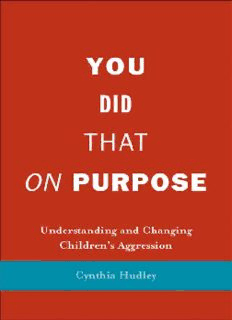
You Did That on Purpose: Understanding and Changing Children's Aggression PDF
Preview You Did That on Purpose: Understanding and Changing Children's Aggression
You Did That on Purpose This page intentionally left blank YOU DID THAT ON PURPOSE Understanding and Changing Children’s Aggression Cynthia Hudley Yale University Press New Haven & London Copyright ∫ 2008 by Cynthia Hudley. All rights reserved. This book may not be reproduced, in whole or in part, including illustrations, in any form (beyond that copying permitted by Sections 107 and 108 of the U.S. Copyright Law and except by reviewers for the public press), without written permission from the publishers. Set in Minion Roman type by Keystone Typesetting, Inc., Orwigsburg, Pennsylvania. Printed in the United States of America by Thomson-Shore, Inc., Dexter, Michigan. Library of Congress Cataloging-in-Publication Data Hudley, Cynthia. You did that on purpose : understanding and changing children’s aggression / Cynthia Hudley. p. cm. Includes bibliographical references and index. isbn 978-0-300-11085-2 (alk. paper) 1. Aggressiveness in children. I. Title. bf723.a35h83 2008 155.4%1247—dc22 2008003715 A catalogue record for this book is available from the British Library. The paper in this book meets the guidelines for permanence and durability of the Committee on Production Guidelines for Book Longevity of the Council on Library Resources. 10 9 8 7 6 5 4 3 2 1 This volume is dedicated to: my mother, Cynthia Duke Cox Hudley, an authentic phenomenal woman, without whom I could never have achieved all that I have my husband, James Robert Hodge Cook, whose love, support, and patience have lifted me up throughout this task This page intentionally left blank Contents Preface ix chapter 1. A Look at Children’s Aggression 1 chapter 2. Understanding Intent: One Source of Childhood Aggression 22 chapter 3. The BrainPower Program: A Strategy for Changing Attributions 36 chapter 4. Research on the BrainPower Program: How E√ective Is It? 54 chapter 5. Looking Beyond the Individual Child: What Schools Can Do 83 chapter 6. Childhood Aggression in the Family and the Community 104 chapter 7. Public Policy for Children’s Well-Being 129 References 153 Index 173 This page intentionally left blank Preface This book derives from my enduring interest in children who have what I once thought of as inexplicably aggressive responses in social situations with other children. This interest emerged during my first years, if not weeks, as a teacher in a middle school, referred to euphemistically as an ‘‘opportunity school,’’ for children who were having di≈culty in the regular classroom. Scenes of indignation or outrage were an almost daily occurrence in our small learning com- munity, and I, a novice teacher, struggled to make sense of what these children were doing to one another to arouse such heated aggression. My more experienced colleagues tended to chalk up the intense emoting to hormones. However, we could reliably expect any one of a relatively small, specific group of mostly boys to exhibit such disruptive behavior with some frequency. In the midst of an organized activity, whether it was a quiet, sustained reading period or a lively, cooperative project, one of these young people would invariably lash out at a peer. One of the sta√ would dutifully pull the child aside and ask what brought on the aggressive, unhappy behavior. Just as dutifully, the child would reply, ‘‘He [or she] was ‘looking at me funny, like they were making fun of me.’’’ Or perhaps, ‘‘I saw her [or him] look over at me and then start whispering, and I know they were talking bad about me.’’ Or even, ‘‘Somebody bumped my desk [or book, or shoe]. And I know it
Description: